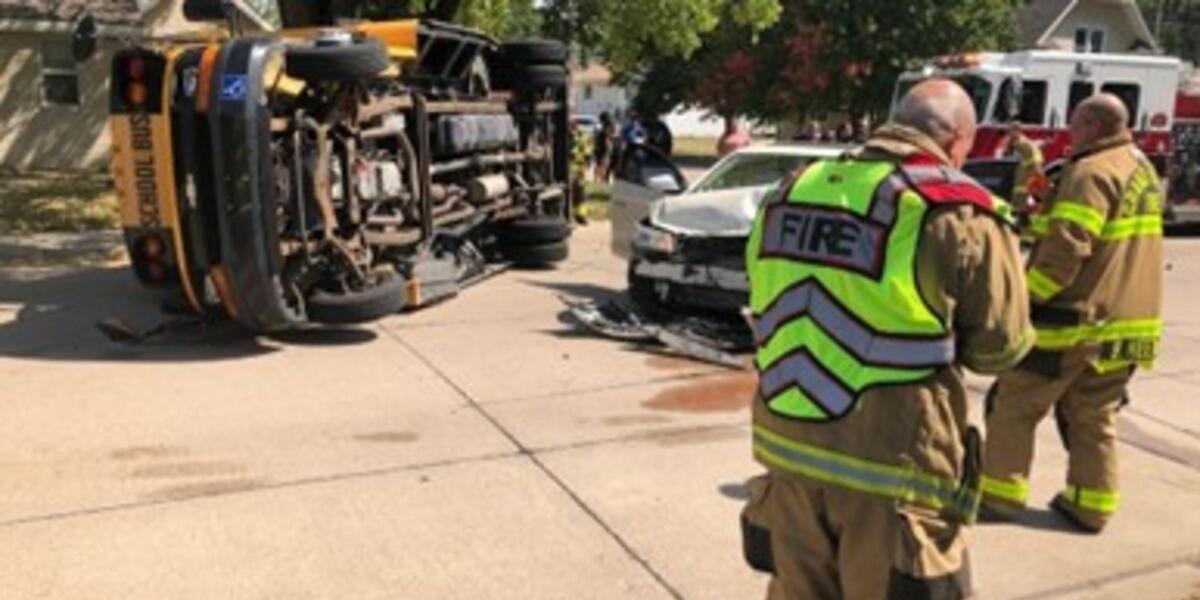Urge Drivers to Stop Illegal School Bus Passing.
Last week in my home state, a car struck a school bus broadside and caused it to roll onto its side. Luckily, there were only three minor injuries. With schools back in full swing, it is a good time to remind your drivers to use extreme caution around buses.
National School Bus Safety Week is October 20–24, 2025. The U.S. Department of Transportation’s National Highway Traffic Safety Administration (NHTSA) is urging drivers to slow down and be aware of school buses in their communities. Although school buses are
among the safest modes of transportation, injuries and fatalities still occur outside or near buses. Most often, these tragedies happen because a motorist failed to slow down and obey the bus’s stop sign or disregarded local traffic laws.
Passing a school bus is illegal nationwide—and it is a deadly risk to bus riders and their caretakers. Drivers should always come to a complete stop when a school bus’s stop-arm is extended and the red lights are flashing.
From 2014 to 2023, there were 1.5 times more fatalities among pedestrians (169) than among occupants of school buses (111) in school-bus-related crashes. A total of 111 school-age children (18 and younger) died in school-bus-related crashes during that period—either as occupants of school buses or other vehicles, or as pedestrians or bicyclists. Of those deaths, 25 were children who were walking.
From 2000 to 2022, there were 55 fatalities in crashes involving a driver illegally passing a stopped school bus. Nearly half of those fatalities (25) were pedestrians who were 18 years old or younger.
When a school bus’s red lights are flashing and the stop-arm is extended, drivers must slow down and come to a complete stop. This is not a suggestion—it is the law. Yellow flashing lights indicate the bus is preparing to stop to load or unload children. This is when motorists should begin slowing down and preparing to stop their vehicles. Motorists may proceed only when the red flashing lights are turned off, the stop-arm is withdrawn, and the bus begins to move.
School bus riders and their caretakers rely on drivers to follow the law and keep them safe.
Respect the “Danger Zone”
The school bus loading and unloading area is called the “Danger Zone.” This is any side of the bus where the driver cannot see a child and, therefore, where the child is in the most danger. These areas include:
-
10 feet in front of the bus, where the driver may be sitting too high to see a child
-
10 feet on either side of the bus, where a child may be in the driver’s blind spots
-
Directly behind the school bus
For more information about school bus stop safety, please visit: NHTSA School Bus Safety.
Have You and Your Employees “Bought” Into Safety?
Years ago, after a driver safety meeting, a driver approached me and said he already knew how to drive safely. He told me he had never had an accident and knew what to do if one occurred—so why was I so intent on “selling” safety to him every chance I had?
I explained that the most important “sale” I could ever make was his life and safety. You may
not be in a buying mood today, but later—tomorrow, next week, next year—it may be too late. By “buying” into safety, your actions may keep not only yourself but others alive.
This is what it will cost you to “buy” into safety:
-
Two seconds to fasten your seat belt
-
Ten minutes for a thorough pre-trip inspection
-
Ten seconds to make sure your mirrors are properly adjusted
-
Two seconds to shut off your cell phone before operating a motor vehicle
-
Eight hours to get proper rest
-
Thirty seconds to clean trash from your vehicle at the end of your trip or route
-
A fraction of a second to flip on your turn signal
-
Two minutes to walk around your vehicle while fueling or stopped to make sure it is in safe order
-
Extra time to account for adverse weather conditions
-
Slowing down in poor weather conditions such as fog, rain, snow, or ice
-
Increasing your following distance
-
Expecting the unexpected
National Truck Driver Appreciation Week: September 14–20, 2025
Nearly every aspect of daily life is made possible because a truck driver delivered the goods and resources people need.
National Truck Driver Appreciation Week is an important time for America to honor and thank all professional truck drivers for their hard work and commitment in performing one of our
economy’s most demanding and vital jobs. These 3.5 million professional men and women not only deliver our goods safely, securely, and on time—they also help keep our highways safe.
Americans and Canadians have taken extraordinary steps to show appreciation for the critical work professional truck drivers perform. From children handing out lunches to “I ♥ Truck” signs along the highways, the public has taken notice of the essential role drivers play in daily life.
As we reflect on the past three years, it is hard to imagine where we would be today if truck drivers had refused to drive at the onset of the COVID-19 pandemic—delivering PPE, food, medical supplies, and more.
This week in September is a small but meaningful way to show appreciation to the 3.5 million professional men and women who deliver our goods safely and reliably while keeping our roads safe. Start planning now to do something special for your drivers during this week set aside to recognize them.










